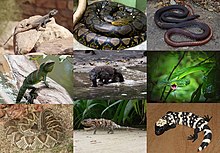| Squamates Temporal range:
| |
|---|---|

| |
| Scientific classification | |
| Domain: | Eukaryota |
| Kingdom: | Animalia |
| Phylum: | Chordata |
| Class: | Reptilia |
| Superorder: | Lepidosauria |
| Order: | Squamata Oppel, 1811 |
| Subgroups[2] | |
| |
Squamata (/skwæˈmeɪtə/, Latin squamatus, 'scaly, having scales') is the largest order of reptiles, comprising lizards and snakes. With over 12,162 species,[3] it is also the second-largest order of extant (living) vertebrates, after the perciform fish. Squamates are distinguished by their skins, which bear horny scales or shields, and must periodically engage in molting. They also possess movable quadrate bones, making possible movement of the upper jaw relative to the neurocranium. This is particularly visible in snakes, which are able to open their mouths very wide to accommodate comparatively large prey. Squamates are the most variably sized living reptiles, ranging from the 16 mm (0.63 in) dwarf gecko (Sphaerodactylus ariasae) to the 6.5 m (21 ft) reticulated python (Malayopython reticulatus). The now-extinct mosasaurs reached lengths over 14 m (46 ft).
Among other reptiles, squamates are most closely related to the tuatara, the last surviving member of the once diverse Rhynchocephalia, with both groups being placed in the clade Lepidosauria.
- ^ Cite error: The named reference
Talanda2022was invoked but never defined (see the help page). - ^ Wiens, J. J.; Hutter, C. R.; Mulcahy, D. G.; Noonan, B. P.; Townsend, T. M.; Sites, J. W.; Reeder, T. W. (2012). "Resolving the phylogeny of lizards and snakes (Squamata) with extensive sampling of genes and species". Biology Letters. 8 (6): 1043–1046. doi:10.1098/rsbl.2012.0703. PMC 3497141. PMID 22993238.
- ^ "Species Numbers (as of May 2021)". reptile-database.org. Archived from the original on 6 October 2021. Retrieved 28 July 2021.